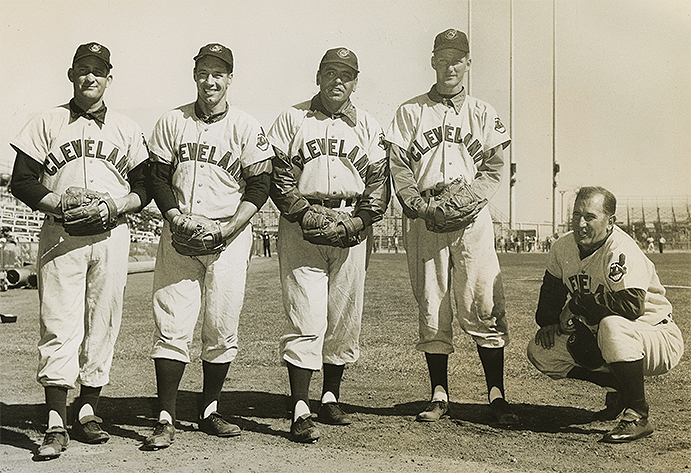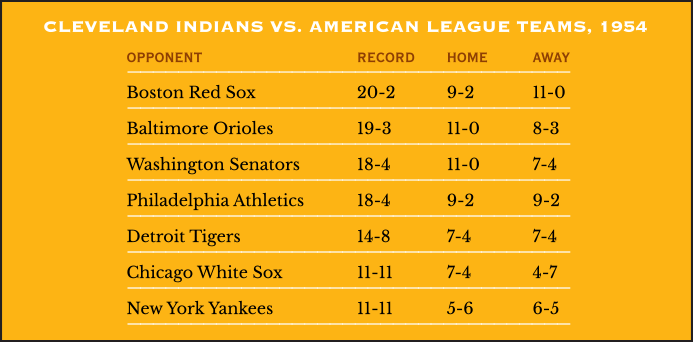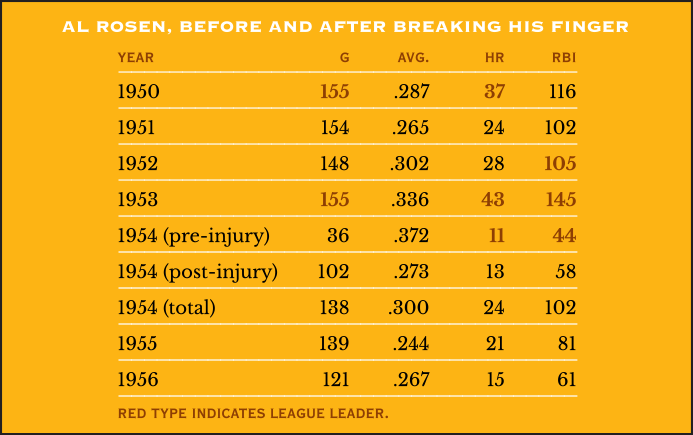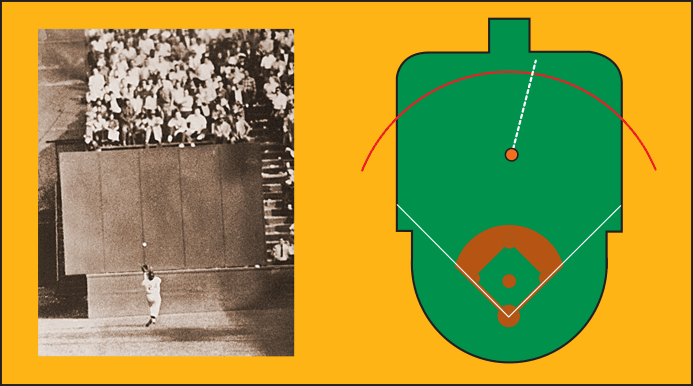THE YEARLY READER
1954: At Least They Stopped the Yanks
Despite having a better year than any of their previous five championship seasons, the New York Yankees are surpassed by a dominant, record-setting Cleveland Indians squad. But it’s the New York Giants who call the shots in the World Series.

Cleveland manager Al Lopez kneels down alongside his pitching horses, from left: Bob Lemon, Bob Feller, Mike Garcia and Herb Score. In a career loaded with frustrating second-place finishes, Lopez guided the 1954 Indians to a dazzling, record-setting 111-43 record. (The Rucker Archive)
In his playing days, Al Lopez longed for the light of the first division, let alone a World Series.
For 19 long seasons, Lopez served as a respected catcher with outstanding defensive skills and a few All-Star Game appearances to his credit. But the teams he labored for—the Bonehead Dodgers and the Bad News Braves of the 1930s, the woebegone Pirates of the 1940s—gave Lopez fat chance to race for the pennant.
Brought into the managerial ranks by the Cleveland Indians in 1951, the soft-spoken, congenial Lopez embarked on a new kind of frustration: Finishing second to the New York Yankees. In his first three years as manager, Lopez’s Indians won 92, 93 and 93 games. But they could not overcome baseball’s 800-pound gorilla in the Yankees, who entered 1954 as the game’s first five-time defending World Series champions.
To conquer the Yankees would be to conquer Everest. You needed great talent, the best of luck, crossed fingers, daily prayers and genuine hope that the planets would align in your favor.
It’s very possible that the Indians met all of those objectives in 1954. Together they forged, by the record, the greatest campaign in American League history.
The achievement was essential. The Yankees were not about to be knocked off the throne quietly, giving the Indians everything they had before the reality sank in that even 110 wins would not be enough to win a sixth straight pennant.
Lopez’s Indians had all the prime assets in place to become their own Goliath. They held one of the strongest pitching staffs of recent memory, led by three quality workhorses: Bob Lemon, Early Wynn and Mike Garcia. Al Rosen had developed into a bona fide power hitter of fearsome quality, and Larry Doby, now seven years removed from his experience as the AL’s first black player, exhibited equal slugging skills at the plate. All the Indians needed to reach the peak, to top the Yankees, was a sound supporting cast.
The season began humbly without the hint of the titanic match yet to come. Braced just above the .500 mark in late May, Cleveland and New York both began working up numerous winning streaks. Surging beyond the rest of what little competition the AL had to offer, the Indians maintained a slim edge over the Yankees through the All-Star break. Historically the beginning of the breaking point for Yankee challengers, the Indians not only held firm, they grew even stronger as wins piled up quickly and without pause. The Yankees, starting to believe this was no ordinary contender, did all they could to ramp up as well.
When, in early September, the Yankees won the last two of a three-game series over the Tribe at New York to reduce the lead to 3.5 games, hope reigned in Casey Stengel’s clubhouse that momentum had finally been created to cause the Indians to start wilting under the pressure. No such luck; Cleveland won seven of its next nine to increase the lead to 6.5 games.
New York had one last shot to make a difference with a Sunday doubleheader at Cleveland—their last two games of the year head-on against the Indians. With a crowd of over 86,000—at the time, a major league record for a regular season game—jammed into Municipal Stadium, the Indians doubly denied the Yankees with 4-1 and 3-2 victories behind excellent starting efforts from Lemon and Wynn. The Indians clinched the pennant just three games later, and provided the exclamation point on the season’s penultimate day with their 111th win—an AL record that would stand for the bulk of the 20th Century.
BTW: Although the 1998 Yankees and 2001 Seattle Mariners would win more games, they both lacked a better winning percentage as a result of playing eight extra games.
And the Meek Shall be Inherited by Cleveland
Over their last five years in Boston before relocating to Milwaukee, the Braves completed an intense downward spiral that began with a NL pennant and ended with a seventh-place finish, minuscule crowds and a call to Wisconsin.

Though just 11-11 against each of the AL’s two other quality teams—the Yankees and the Chicago White Sox—the Indians feasted off a menu of five downtrodden teams that made up the rest of the league, firmly evidenced by an 89-21 record against them.
Pitching was undoubtedly the Indians’ strength. The team’s 2.78 earned run average was the lowest of any AL team since the deadball era. Lemon and Wynn won 23 games apiece to co-lead the AL; Mike Garcia won 19 and led the league with a 2.64 ERA. Bob Feller, playing out the string of a quickly decaying career, rose to the occasion and won 13 of his 19 starts, losing only three. The Cleveland bullpen, meanwhile, became the heart of that supporting cast the Indians were looking for. It was headed by two rookies—left-hander Don Mossi and right-hander Ray Narleski—who combined to save 20 games while opposing batters hit under .200. If that wasn’t enough, the bullpen was also anchored by former two-time MVP Hal Newhouser, who’d been discarded the year before by the Tigers and, like Feller, gave it one last hurrah by winning seven and saving seven in 25 relief appearances.
Underscoring the Indians’ spirit, the entire staff resolved to brush back opposing hitters with aggressive abandon to protect their own—two of whom were black (Doby and outfielder Al Smith), another Jewish (Rosen)—who were getting knocked around by other AL clubs taking their time integrating into more politically correct times.
At the plate, the Indians were solid. Rosen began the year in crackerjack style to rival his MVP performance of the year before, but then he busted a finger on defense; playing hurt the rest of the year, his numbers were tempered to a still-respectable .300 batting average with 24 homers and 102 runs batted in. Second baseman Bobby Avila, battling stomach ulcers all year, managed to lead the league in hitting at .341. Larry Doby avoided any injury bugs and led the AL with 32 homers and 126 RBIs. A key mid-season trade brought over Vic Wertz, struggling with the lowly Baltimore Orioles—but revived in a winning atmosphere at Cleveland, clubbing 14 homers with 48 RBIs in 94 games.
Bloom off the Rosen
Not since the reckless Pete Reiser had baseball seen greatness lost—until Al Rosen. The year before, he had come within a single batting point of winning the hitter’s triple crown, and was eerily in the same exact position in late May when he mishandled a grounder that fractured his finger. Playing on rather than allowing the finger to heal, Rosen would never be the same player again, retiring two years later.

The New York Yankees gave it all their might, but still finished a full eight games behind the Indians—in spite of winning 103 games, more than any of their previous five World Series-winning years. Mickey Mantle (.300 batting average, 27 home runs, 102 RBIs) and Yogi Berra (.307, 22, 125) continued to shine offensively, and a dependable (if aging) pitching staff was lifted by rookie Bob Grim’s 20-6 record. But there were cracks in Casey Stengel’s mirrors, most notably in the middle of the infield as Phil Rizzuto and Jerry Coleman struggled horribly at the plate while Billy Martin was nabbed for military service.
Of New York City’s three major league ballclubs, little promise was afforded that it would be the Giants, not the Yankees or Dodgers, who would be still standing at World Series time.
In the three years since winning the National League pennant, the Giants had deteriorated—most precipitously in 1953 with a substandard fifth-place showing. Most experts sensed Leo Durocher’s team was handicapped with the year-long loss of Willie Mays, still doing time in the Army.
Mays returned in 1954 and, preserved like fine wine, tore apart the rest of the league with a breakout performance after a relative year’s worth of growing up from 1951-52. The 23-year old slammed 41 homers, knocked in 110 runs and won the batting title at .345 on the season’s last day when he overtook challengers in teammate Don Mueller (.342) and Brooklyn’s Duke Snider (.341). Mays was as much a marvel on the field as he was at bat, patrolling the Polo Grounds’ vast center field with incredible range.
The Giants were re-ignited by Mays, grabbing first place in June—a month during which they would win 24 of 28 games. They sailed through the summer and never relinquished the lead.
There were key ingredients to the Giants’ success beyond Mays. Pitcher Johnny Antonelli was acquired in a preseason trade that sent the popular Bobby Thomson to Milwaukee. Though other players were involved, Giants fans initially didn’t see the value in giving up their beloved hero of 1951 for a pitcher whose 12-12 record the year before was the best of his career. But Antonelli quickly returned smiles to their faces, winning his first 12 games at the Polo Grounds on his way to an overall 21-7 record with a league-leading 2.30 ERA and six shutouts.
BTW: Milwaukee fans thought they, too, got the raw end of the deal when Thomson broke his ankle in spring training—but his injury opened an outfield spot for 20-year-old Hank Aaron.
The other piece of the pennant-winning puzzle spent most of his time on the bench. Left-handed slugger Dusty Rhodes was often called upon to pinch-hit and save the day when the rest of the team couldn’t do it. Often, Rhodes successfully answered the call, batting .341 with 15 homers and 50 RBIs—in just 164 at-bats.
Five games behind the Giants, the two-time defending NL champion Brooklyn Dodgers continued to muscle the ball impressively, but not even the return of Don Newcombe from the military could save a pitching staff that collapsed.
The Giants’ 97 regular season victories paled next to Cleveland’s numerically awesome 111-43 mark, and thus they were instantly branded as big-time World Series underdogs. And when Vic Wertz tripled in two runs to start off Game One at the Polo Grounds, everything seemed to be in order for the anticipated Cleveland rout. But the Giants rallied to tie the game in the third inning, and a pitcher’s duel settled in as Bob Lemon and Sal Maglie traded zeroes on the scoreboard.
In the eighth, the first two Indians reached base and up came Wertz—who to that moment had added two other hits to go with the triple. Leo Durocher figured that Maglie wasn’t going to have any better luck facing Wertz a fourth time around, so the Giants manager replaced him with Don Liddle, who had accompanied Antonelli in the trade from Milwaukee.
Wertz found Liddle to be no less a mystery than Maglie, launching a deep drive to straightaway center. In any other ballpark it would have cleared the fence, but this was the Polo Grounds—with its bizarre, bathtub-like field dimensions of a mere 260 feet down the lines and 480 to dead center. Willie Mays, who was playing in, tore off after Wertz’s drive and, like a wide receiver somehow catching up to an overthrown bomb, made a sensational over-the-shoulder catch—some 450 feet from Wertz’s bat. The amazement was not in how Mays caught the ball, but that he was just able to catch up to it.
The play, forever to be known in history simply as “The Catch,” is probably the game’s most overrated moment in terms of its technical merits; even Mays said he’d made many more difficult plays over his career. But it was an emotional backbreaker for the Indians, and they were further wounded when Dusty Rhodes came off the bench in the 10th inning and finally broke the tie with a three-run homer off Lemon, down the right field line—260 feet away from home plate. Wertz’s out had traveled nearly 200 feet longer, but such were the intricacies of the Polo Grounds.
Anatomy of a Catch
To place perspective on just how amazing “The Catch” by Willie Mays (below, left) in Game Two of the World Series was, the dimensions of New York’s Polo Grounds are compared to the average dimensions (red line) of today’s ballparks—and show how Mays’ track to Vic Wertz’s booming fly, 450 feet from home plate, would leave most modern center fielders impressed. (Photo: Associated Press)

Reeling from the heartbreak of Game One and from numerous, small physical ailments, the Indians couldn’t get it going the rest of the way. More importantly, they couldn’t get Dusty Rhodes out; the pinch-hitter stroked a run-scoring single to help erase an early 1-0 Indians lead in Game Two, and added an insurance homer after staying in to aide Antonelli, who went the distance to win, 3-1. In Game Three at Cleveland, Rhodes singled in two more in another off-the-bench assignment, helping the Giants to a 6-2 win. Rhodes stayed on the bench for Game Four as the Giants stormed to a 7-0 lead, holding on to win 7-4 and score a stunning sweep of the heralded Indians—who stalled at the plate throughout, batting just .190 with nine runs scored in four losses.
BTW: No single Indians player had more than three hits in the World Series except Vic Wertz—who was 8-for-16 with two doubles, a triple, a home run and an extra base hit robbed by Willie Mays.
For the Giants, it would be their last World Series triumph for over 50 years—and their last in New York. As for Cleveland, the bloom would quickly be off the rose as a disgruntled Al Lopez would leave the team a few years later, talent would fall off, and the Indians would settle into a four-decade dormancy that would eventually lower their standing to that of lovable laughingstocks.
If not for a Giant derailment in October, it could have been the greatest season ever.
 Forward to 1955: Next Year at Last At long last, the Brooklyn Dodgers secure their first—and only—world championship.
Forward to 1955: Next Year at Last At long last, the Brooklyn Dodgers secure their first—and only—world championship.
 Back to 1953: Brave New World After 50 years of geographical entrenchment, baseball begins an active era of relocation and makes Milwaukee its first benefactor.
Back to 1953: Brave New World After 50 years of geographical entrenchment, baseball begins an active era of relocation and makes Milwaukee its first benefactor.
 1954 Leaders & Honors Our list of baseball’s top 10 hitters and pitchers in both the American League and National League for the 1954 baseball season, as well as the awards and honors given to the game’s top achievers of the year.
1954 Leaders & Honors Our list of baseball’s top 10 hitters and pitchers in both the American League and National League for the 1954 baseball season, as well as the awards and honors given to the game’s top achievers of the year.
 The 1950s: A Monopoly of Success Though described as a golden age for baseball, most major league teams find themselves struggling—unless you’re in New York City, where the Yankees, Dodgers and Giants hog the World Series podium from 1950-56. But as the decade winds to a close, the euphoria of Big Apple baseball will rot overnight.
The 1950s: A Monopoly of Success Though described as a golden age for baseball, most major league teams find themselves struggling—unless you’re in New York City, where the Yankees, Dodgers and Giants hog the World Series podium from 1950-56. But as the decade winds to a close, the euphoria of Big Apple baseball will rot overnight.


 Former pitcher Don Mossi talks of his struggles trying to break the Indians’ vaunted rotation of the 1950s, losing to the Giants in the 1954 World Series, and his later baseball life with the Tigers and A’s.
Former pitcher Don Mossi talks of his struggles trying to break the Indians’ vaunted rotation of the 1950s, losing to the Giants in the 1954 World Series, and his later baseball life with the Tigers and A’s. An interview with Joey Amalfitano, who was a member one World Series champion (the 1954 Giants) as a ‘bonus baby’ prospect, and another (the 1988 Dodgers) as a third base coach.
An interview with Joey Amalfitano, who was a member one World Series champion (the 1954 Giants) as a ‘bonus baby’ prospect, and another (the 1988 Dodgers) as a third base coach. Pinch-hitter extraordinaire Dave Philley discusses why he got traded so often, the overconfifence of the 1954 Indians and how Willie Mays’ famous catch was much ado about nothing.
Pinch-hitter extraordinaire Dave Philley discusses why he got traded so often, the overconfifence of the 1954 Indians and how Willie Mays’ famous catch was much ado about nothing. Connie Marrero joined the majors at age 38 after a life of pitching excellence in Cuba. At age 100, he looks back at his career.
Connie Marrero joined the majors at age 38 after a life of pitching excellence in Cuba. At age 100, he looks back at his career.


